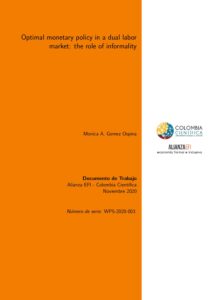In this paper I analyze the optimal monetary policy in emerging countries whose labor markets are mainly characterized by the presence of a large informal sector. I develop a closed economy model with nominal price and wage rigidities, search and matching frictions and a dual labor market. A formal one characterized by matching frictions, and nominal wage rigidities, and an informal one where wages are fully flexible. Under this framework, a trade-off between price and wage inflation emerges. I find that informality increases the response of price and wage inflation to aggregate productivity shocks. As a result, the presence of an informal sector increases the inefficient fluctuations of the labor market variables, such as unemployment, labor market tightness, and formal hiring rate. I derive the second-order approximation to the welfare of the representative agent, and then I characterize the optimal monetary policy for standard calibration of the model. I find that optimal policy with informality features significant deviations from price stability in response to aggregate productivity shocks.
Autores:
- Monica A. Gomez Ospina
Palabras clave:
- Inflation targeting
- Informality
- Monetary policy
- Nominal wage and price rigidities
Categorías:
- Proyecto 5
- Documentos de trabajo
